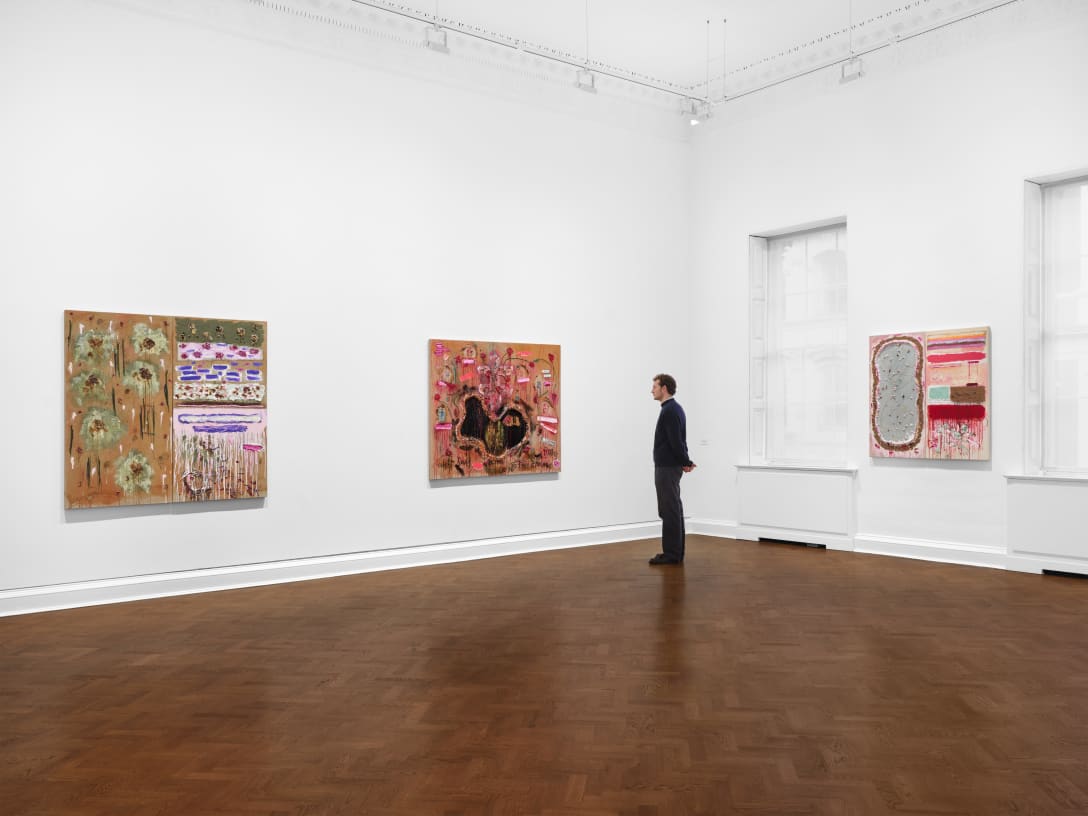

Overview
Brandenburg "examines in drawing the masks and symbols of a ruthless event culture: the ritual outfits of football fans, the chubby bodies of fairground figures and mascots, the slogans and symbols on pennants, banners and billboards"
Galerie Thaddaeus Ropac is holding its fifth solo exhibition of works by artist Marc Brandenburg, resident in Berlin. Entitled Alpha St, the exhibition comprises 24 drawings from a new series of works based on historical photographs of traditional costumes and on snapshots of young people in school uniforms.
"The drawings of women enveloped in their clothes and immobilised like ghostly figures from another age show a fascination for superficial detail. The portrait drawings are based on photographs of women in traditional costumes taken in the 1940s that have been inverted and alienated by the artist through processes of copying and manipulating. Brandenburg emphasises the averted gaze and frozen gestures of the featured women, making their faces and bodies appear immobile, like those of wooden dolls.
The patterns of the elaborate handmade lace and embroidery, resembling decorative armour, are transposed into the social structures of a present time: that of schoolgirls' uniforms. The groups of girls – teenagers chatting amongst themselves, unaware of the spectator's gaze – emerge dimly from a white haze, like scenic souvenir pictures from a distant past. These are modelled on Brandenburg's own photographs, snapshots taken during a trip to New Zealand and Australia.
The subjects, shown here presumably as objects or textures of a social environment, are exclusively female. The striking feature is the sign Alpha Street, isolated from its context and thus pointing nowhere. A narration takes shape, with the viewer in the role of the spectator of a dreamlike, surreal sequence – at once detached, excluded and ensnared in a crippling perpetuity between past and future" (Anna Vetter).
At first glance, Brandenburg's almost spectrally delicate pencil drawings seem like negatives of snapshots of a bizarre parallel world. His realistic scenes with public demonstrators, flag-waving football fans, clowns and fairgrounds, his portraits of friends and relatives, his water fountains and monumental Christmas decorations have an unsettlingly threatening effect. The silvery, shiny materiality of the graphite surfaces is combined with finely-nuanced, gently tapering contours. Everything is bathed in a blaze of unreal light. The motifs on the white paper seem deprived of their original peaceful quality. The way he models the surface structures immerses the images from everyday life "in an acid bath of abstraction" (Harald Fricke).
Brandenburg "examines in drawing the masks and symbols of a ruthless event culture: the ritual outfits of football fans, the chubby bodies of fairground figures and mascots, the slogans and symbols on pennants, banners and billboards" (Oliver Koerner von Gustorf). He draws mostly from his own photographs, which attempt to capture the moment of veering from one motif to another. His concern is what lies between them: "It's like a cut in film, or like individual stills that make up a film – it's like trying to depict an aura", Brandenburg once explained in an interview.
In his speech at the 2005 award ceremony of the prestigious Karl Ströher Prize to Marc Brandenburg in the Frankfurt Museum of Modern Art, writer Ulf Poschardt remarked that although Brandenburg stands in the tradition of pop art and its delight in surface appearance, he still combines the aspects of realism and transfiguration in a contemporary manner. He added that "it was not so much the media world and its images that Brandenburg captured, but rather moments of experienced intensity. A timid viewer (and aren't we all, when confronted with delicate, intimate drawings?) has the feeling that he is looking at the photo negatives of a deeply-felt life. The sheer technical skill and refinement of Marc Brandenburg's work has perpetuated the snapshot. The moment is endowed with permanence. The shock of the moment has been sketched into permanency." There is an evident affinity with the 19th-century genre and history portraitist Adolf von Menzel, whom Brandenburg greatly admires. Also Berlin protagonists of the New Objectivity – such as Otto Dix and George Grosz – may be seen as precursors of Brandenburg.
Brandenburg's iconography often draws on scenes showing loss of control and extreme physicality. In 2008 Diedrich Diederichsen, writing about Brandenburg's aesthetics of excess, said that "the visual grammar of excess is essentially that of an accelerated or accelerating change-over of images which are in themselves clearly contoured. Their smallest element is the stroboscopic flash, alternately bright and darkened images where the bright parts produce a sequence of their own; this is at once excessively bright, leaping out aggressively at the viewer, yet still kept at a distance by the dark interruptions, the effect of proximity thus being mitigated. Brandenburg's drawings endow this experience of the world with intensity and permanence."
Marc Brandenburg, born in Berlin in 1965, grew up in Germany and Texas, USA. He gained a wide reputation during the 1990s with his distinctive pencil drawings. Today, his works are represented in collections worldwide, including the MoMA/New York, Deutsche Bank, Kupferstichkabinett/Berlin, Kunsthalle/Hamburg, Harlem Studio Museum/New York, Kupferstichkabinett/Dresden, Städtische Galerie/Wolfsburg and Museum Moderner Kunst/Frankfurt, and have been exhibited in international museums. In recent years, Kunsthaus/Stade (2015), Städtische Galerie/Wolfsburg (2012), Kunsthalle/Hamburg (2011) and Denver Art Museum (2010) have devoted major solo exhibitions to his work.














































































































































































